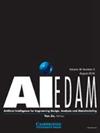Machine learning model to predict tensile properties of annealed Ti6Al4V parts prepared by selective laser melting
IF 2.3
3区 工程技术
Q3 COMPUTER SCIENCE, ARTIFICIAL INTELLIGENCE
Ai Edam-Artificial Intelligence for Engineering Design Analysis and Manufacturing
Pub Date : 2022-09-29
DOI:10.1017/S0890060422000117
引用次数: 1
Abstract
Abstract In this work, an artificial neural network model is established to understand the relationship among the tensile properties of as-printed Ti6Al4V parts, annealing parameters, and the tensile properties of annealed Ti6Al4V parts. The database was established by collecting published reports on the annealing treatment of selective laser melting (SLM) Ti6Al4V, from 2006 to 2020. Using the established model, it is possible to prescribe annealing parameters and predict properties after annealing for SLM Ti-6Al-4V parts with high confidence. The model shows high accuracy in the prediction of yield strength (YS) and ultimate tensile strength (UTS). It is found that the YS and UTS are sensitive to the annealing parameters, including temperature and holding time. The YS and UTS are also sensitive to initial YS and UTS of as-printed parts. The model suggests that an annealing process of the holding time of fewer than 4 h and the holding temperature lower than 850°C is desirable for as-printed Ti6Al4V parts to reach the YS required by the ASTM standard. By studying the collected data of microstructure and tensile properties of annealed Ti6Al4V, a new Hall-Petch relationship is proposed to correlate grain size and YS for annealed SLM Ti6Al4V parts in this work. The prediction of strain to failure shows lower accuracy compared with the predictions of YS and UTS due to the large scattering of the experimental data collected from the published reports.机器学习模型预测选择性激光熔化Ti6Al4V退火零件的拉伸性能
摘要:本文建立了人工神经网络模型来理解打印Ti6Al4V零件的拉伸性能、退火参数和退火Ti6Al4V零件拉伸性能之间的关系。该数据库是通过收集2006年至2020年发表的关于选择性激光熔化(SLM) Ti6Al4V退火处理的报告而建立的。利用所建立的模型,可以对SLM Ti-6Al-4V零件的退火参数和退火后的性能进行高置信度的预测。该模型在预测屈服强度(YS)和极限抗拉强度(UTS)方面具有较高的准确性。结果表明,YS和UTS对退火参数(温度和保温时间)较为敏感。YS和UTS对打印零件的初始YS和UTS也很敏感。该模型表明,为了使Ti6Al4V零件达到ASTM标准要求的YS,理想的退火工艺是保温时间少于4小时,保温温度低于850℃。通过对收集到的退火Ti6Al4V组织和拉伸性能数据的研究,提出了一种新的Hall-Petch关系,将退火后的SLM Ti6Al4V零件的晶粒尺寸与YS相关联。由于从已发表的报告中收集的实验数据的大散射,与YS和UTS的预测相比,应变到失效的预测精度较低。
本文章由计算机程序翻译,如有差异,请以英文原文为准。
求助全文
约1分钟内获得全文
求助全文
来源期刊
CiteScore
4.40
自引率
14.30%
发文量
27
审稿时长
>12 weeks
期刊介绍:
The journal publishes original articles about significant AI theory and applications based on the most up-to-date research in all branches and phases of engineering. Suitable topics include: analysis and evaluation; selection; configuration and design; manufacturing and assembly; and concurrent engineering. Specifically, the journal is interested in the use of AI in planning, design, analysis, simulation, qualitative reasoning, spatial reasoning and graphics, manufacturing, assembly, process planning, scheduling, numerical analysis, optimization, distributed systems, multi-agent applications, cooperation, cognitive modeling, learning and creativity. AI EDAM is also interested in original, major applications of state-of-the-art knowledge-based techniques to important engineering problems.

 求助内容:
求助内容: 应助结果提醒方式:
应助结果提醒方式:


